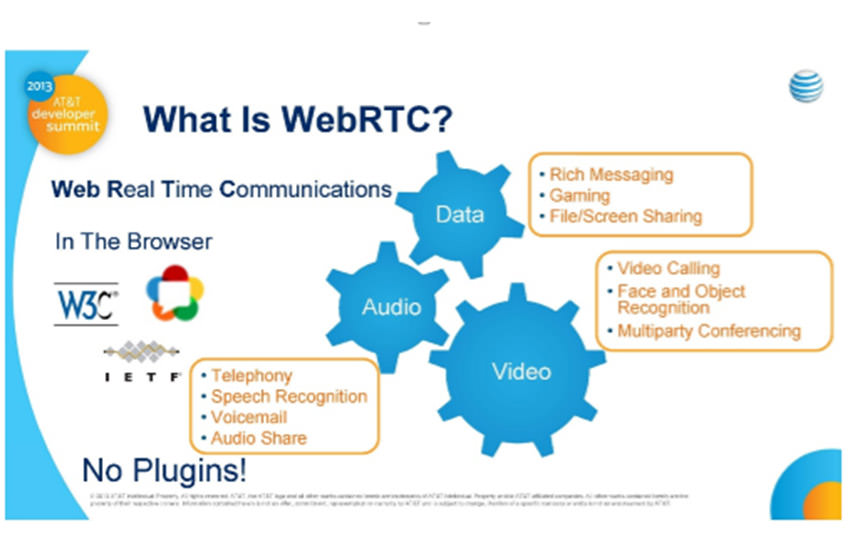How WebRTC is better than Closed Online Communication Tools for Enterprises?

Communication has witnessed a major change in the recent few years. From landline phones to mobile phones, and from postal mails to emails, SMS, and instant messengers, people now have umpteen ways to be in touch with one another and carry on with their business or social engagements. WebRTC is yet another advanced version to find its mention in the latest communication modes in this context, which involves browsers based communication. It is rated as better than closed online communication tools for enterprises, but whether this consideration holds any water is worth checking out.
What is WebRTC?
An abbreviation for Web Real Time Communication, WebRTC is a free, open source project that enables users to do browser-to-browser audio and video chats and P2P file sharing. It aims at enabling the development community to access open, superior-quality real-time technology that was until now available to only reputed enterprises, due to the accompanied expensive licensing fee or through Adobe Flash like proprietary plugins.
Drafted by W3C in collaboration with IETF’s RTC Web standard and supported by Google, Mozilla and Opera, the communication standard has already been included in the recent versions of Firefox, Chrome and Opera. All its components or RTC applications are plugin independent and can be accessed with the help of a JavaScript API, which also encourages developers to come up with their own browser based RTC web apps.
Facts and figures
The fast increasing popularity of WebRTC can be inferred by below mentioned stats:
- In a 2013 survey conducted by Dialogic, about 87% of 168 respondents, including developers and service providers, agreed on the possibility of a significant impact of WebRTC on their product roadmaps, which could then affect the implementation of WebRTC applications at Enterprises’ end.
- In the same survey, approximately 60% participants considered the browser-based feature of WebRTC as a highly disruptive aspect. Web service model and open source technology were among the other of the preferred disruptive aspects.
- Another survey by Tokbox in 2013 including 1,161 respondents from the developer community, found the adoption of WebRTC by SMBs and corporate heavyweights as a rapidly growing phenomenon. The report showed that 75% of developers expressed their will to double the use of WebRTC usage in the next 12 months.
Advantages
Though still in the nascent stages of development and refinement, WebRTC ensures a roster of benefits for users, developers and integrators that were lagging behind in the erstwhile collaboration platforms.
- Secure and logical architecture: WebRTC comprises better architecture as compared to the Flash plugin in terms of logic. Furthermore, it provides better security and stability to browsers against outside attacks. The Secure RTP protocol (SRTP) encrypts and authenticates both the voice as well as video.
- Free and open: Since the time Google introduced WebRTC as an Open Source API in 2011, it has lived up to its objective of delivering real-time and standard-based media engine free of cost and in the currently available browsers.
- Platform and device independence: Users can communicate with each other on a WebRTC enabled browser, without being dependent on any operating system or computing device. This has been made possible by implementing standard IETF protocols, and W3C APIs. Developers can write specific HTML5 code to run WebRTC on multiple computing devices.
- Adaptive to media types: Irrespective of the network conditions, the WebRTC APIs are well equipped to negotiate numerous media types for format and size. This ultimately leads to effective bandwidth usage and hence, high quality voice & video communication.
Disadvantages of WebRTC
While there are multiple benefits of using WebRTC, it has also certain demerits, such as:
- Prone to changes: Considering the fact the WebRTC is still under development phase, it is likely to experience loads of code changes in the better future. Hence, until a stable final version is released, nothing much can be said about its overall performance.
- Unique codec: There is an absence of a main codec that could be supported by all the browsers, to present WebRTC as a viable cross platform facility. Currently, the royalty free VP8 codec is used, however Cisco and some other companies emphasize on using H.265, the paid codec, which violates WebRTC principle of using royalty free solutions. This also poses problems form 3rd party developers.
However, considering the promising future of WebRTC, its disadvantages are likely to shed off and an improved final version of the communication standard could well do the rounds with a unique main codec.
To summarize, WebRTC is a welcome revelation over the earlier and existing closed communication modes as it is independent of any platform or device. It allows the users to exchange voice and video chats as well as file sharing over P2P network comfortably, using web browsers. If Google and other of its supporters pay attention to the probable shortcoming in the existing version, chances are better that WebRTC comes out to be an ultimate browser based, platform independent communication standard in the near future.
Finoit takes immense pleasure in leveraging upscale technologies to provide reliable IT solutions to its global clients. We hold credible experience in developing quality native as well as cross platform applications for iOS, Android, as well as Windows Phone devices.
To know more about our services or to avail the benefits of our bankable IT solutions, please feel free to contact us at the earnest.

